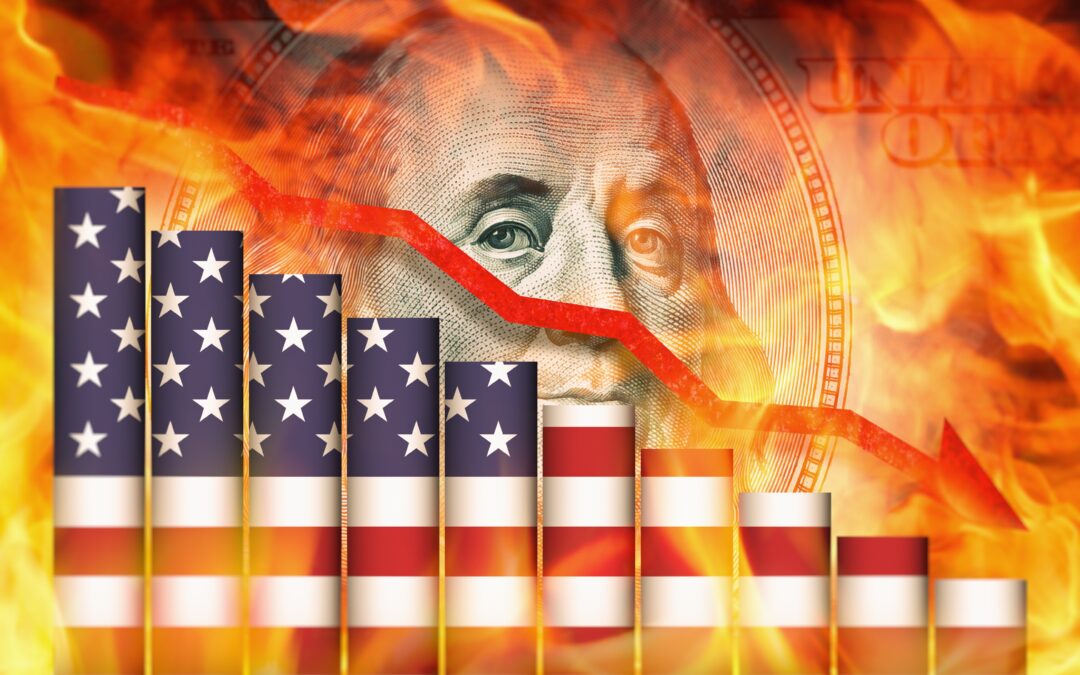It’s time to face the facts — America is in a jobs recession.
After this week’s massive revision revealed nearly a million fewer jobs added, we gained a clearer picture about the health of the American economy, and the legacy President Biden left behind.
Now the question is; what comes next?
What’s the Federal Reserve going to do to rejuvenate the job market and get things back on track?
Find out in today’s episode of Moneyball Economics.
Click the video below to get started:
Video transcript:
This is Moneyball Economics. I’m Andrew Zatlin, and next week it’s Showtime.
Next week the Federal Reserve meets, and they’re going to answer the question: interest rate cuts … yes or no? But the real question isn’t interest rate cuts. It’s how deep you’re going to go.
I’m a big proponent of 50 basis points, and that has been lonely. That position has been very lonely for a while, but I think everyone’s starting to accept and acknowledge that 50 basis points is likely on the table. This will surprise the markets, and that’s going to create opportunities, which we’re going to talk about in a minute.
First, let me lay out the case why we’re going to see a 50 basis point cut next week and additional rate cuts in a couple of months.
It starts off with last month. The payroll number that came out for August was weak. It means that we’ve had four consecutive months of really weak payrolls, double digit growth, not good. In fact, it looks like that was enough to make the fed cut rates a little bit.
But what’s going to tip them over into the 50 basis point area is the other data that came out this week. First of all, we have jobless claims looking soggy last week, 263,000 this week. Now they’re all up on these bizarre one-offs, but it doesn’t matter.
The optics say the labor market is not looking strong, but there’s a third data point that came out this week that really was eye catching…
Let me explain a little bit about how they build payrolls. They start off with an assumption about the size of the labor force, and then they take a model that adjusts each month. So they get information from employers, they take that information and they extrapolate and model and say, well, if we started with 130 million jobs, this information tells us another X percent jobs were added in.
They were in this area, in that sector, and so on and so forth. The problem though is the data collection is just really bad at this point. They send out a survey to a hundred thousand companies, but they only get responses from maybe 30, 35,000, and that’s to cover the entire economy. It’s not a lot. It’s a pretty small data sample. But once a year, what they do is they do a true up.
What they do once a year is they go in and they look at how many people paid payroll taxes because paid payroll taxes if you’re working, and they use that to re-baseline the model. Okay, if we’ve got 130 million, boom, boom, boom, let’s look back. Oh, it looks like we had 130.5 million, or whatever they do.
Well, unfortunately, for anybody who thinks we’re in a bull market, they just announced this week that they overstated the size of the payroll population and they’re going to be cutting almost a million payrolls out.
So let me put this in perspective. Last year when Biden was president, everyone was rallying for omics. Why? Well, the data shows strong job market. 200,000 jobs are being created each month. That’s a good job market. Two and a half million people, two and a half million jobs created in one year. Well, fast forward, and what we now know this week is it’s barely a million that in fact, you take last year’s barely a million and now this year’s barely 500,000. Not even.
We are firmly in a job recession firmly, deeply in a job recession. In fact, payroll is contracted this year, one month.
So if you’re the Fed, you’re looking at this, you’re in panic mode right now. Why would they resist going deep Again, we’ve got inflation out there. Inflation’s their boogeyman, inflation’s the barrier to cutting, to cutting at all. However, even that this week, well, we got the latest producer price index and the latest consumer price index, and both of them were flat to the prior month or even down a little bit.
Let me tell you a little bit more about that. So here we are. Tariffs came in and everybody including me, expected the tariff pressure to raise inflation. Now, we didn’t know at the time in April how big the tariffs would be, but one thing became clear as we saw over time that the tariffs actually were going to be closer to 15% and that’s on goods and then gets diluted as it works its way through the economy. April, may, June, July, August.
So five months into this tariff world, what we’re finding is that really isn’t that bad.
Well, I mean some sectors, we’re seeing inflation that’s tariff driven. You try to buy furniture, you try to buy equipment, you try to buy steel. Oh yeah, you’re definitely seeing inflation and insurance as well. You want to see a doctor, oh, no matter what, they’re raising their prices no matter what, but overall, inflation’s not a problem.
So if you’re the Federal Reserve, you’re going to have to take a step back, which is more persistent and problematic inflation that’s flat and possibly starting to tilt down, but it’s high or a massive job recession where we’re now looking at basically adding no jobs whatsoever. Well, if you’re the Fed, you’re going to have to go deep and you’re going to go deep, not just once, but you’re going to go deep again over the next six months, you’re probably going to hit at least two more rate cuts, possibly even three.
But I’ll settle for two, meaning next week, 50 basis points to stop this job recession, and then another 25 by the end of the year and another 25 at the beginning of the year. These rate cuts are going to work their way through the economy in different ways for businesses. They’re going to ignore it.
Not that they don’t like rate cuts, but there are two reasons why they’re going to ignore this one coming up. The first is just seasonality. It’s September October’s right around the corner. Companies are starting to wind down their projects. They’re not going to suddenly ramp up a lot of capital spending. It’s not the way it works. It’s not the way it works, right?
In particular, the second reason, because they’re so focused laser-like on cost containment, companies are not seeing substantial profit growth at the moment. Last year it was double digits and now we know why. It’s because they weren’t really hiring this year. Same thing, but that double digit, it’s now in the mid-single digit and they’re achieving that purely by cost management. They’re not going to be triggered to go out and spend right now.
So that 50 basis point cut won’t be rippling through the corporate world anytime soon.
The story’s a little different next year when they come back from vacation. Right now though, this year it’s economic weakness. It doesn’t move the dial. But for the other part of the private sector consumers, this is nice. 25 basis point cut doesn’t get anybody’s attention, but 50 basis point cut. Now we’re talking about an opportunity to refinance. We’re talking about debt service costs going down, putting money in people’s pockets. I mean, you start checking off the boxes. This puts money into consumer’s wallets.
So banks are sitting pretty, I’m already getting refi and balance transfer options in the mail like you wouldn’t believe. They want to lock me in before rates go down and down and down. Banks are sitting pretty, there’s going to be a lot of activity coming their way. Retailers are sitting pretty, let’s face it, we’re putting money back into people’s pockets right before the holiday season.
That’s going to definitely help people out and help out retailers. And of course, I’ve been talking about gold and a lot of the other asset classes that are sensitive to interest rates and inflation because this kind of perks up inflation. It at least keeps it where it is today.
Fast forward next year, well, it’s a different story Next year I think we’re going to see companies come in. I think we are going to see the economy start to take off next year, but that’s next year. As this year starts to move forward, I think the economy’s going to start limping along problematically. So the fed’s going to be doing another rate cut, and of course Santa Don is going to come in…
Trump is going to throw some kind of tariff dividend reward to households towards the end of the year. He’s got the money, and now he’s panicking too because we’re going to have a very slow economy in the fourth quarter, and he hates that, especially as we go into the midterm elections.
So he’s going to want to do something to stimulate the economy and for once monetary and fiscal policy are aligned, and we get to next year, got a couple more things happening, companies coming online, probably going to do some more hiring, ramping up. We’ve got clarity around tariffs and oh, by the way, we’ve got the big beautiful bill, this tax bill that came out that’s going to put money in people’s pockets in April. It’s basically how do you get to April time? September.
April’s a long way away and companies aren’t really motivated to hire right now. You got to stimulate it. So that’s why I think we’re going to see a hundred basis points total between now and tax season, and we’re going to see some kind of dividend or handout from the government. All of this is just fantastic for retailers.
I happen to love Walmart and I happen to love Amazon in particular because while this is going on, you don’t have a lot of competition from China. Temu and Shine and Alibaba are now suffering and all the business they were picking up, it’s going to go right back to Amazon during holiday shopping season.
We’re into win it folks. Let’s get some money out there.
Zatlin out.

Andrew Zatlin
Editor, Moneyball Economics





